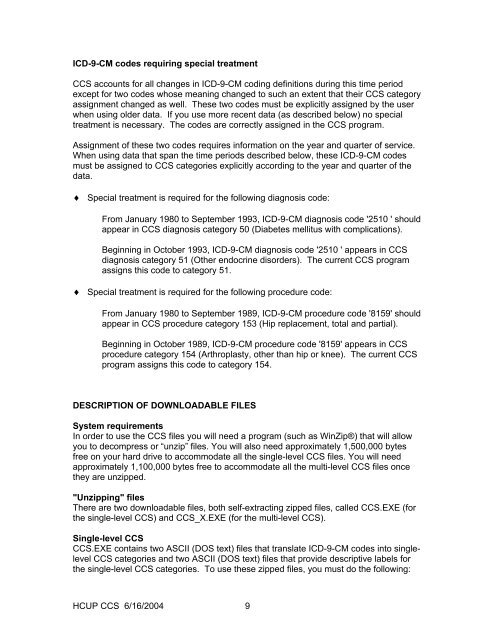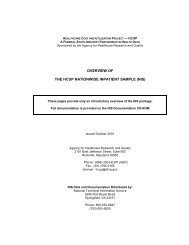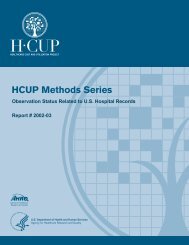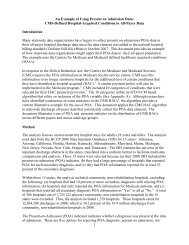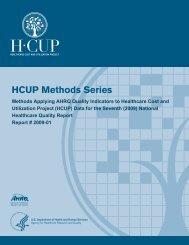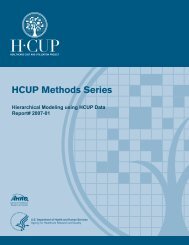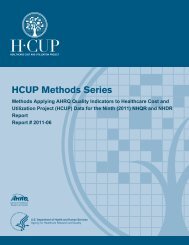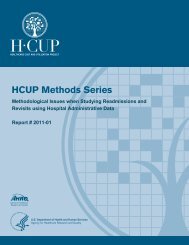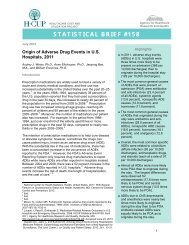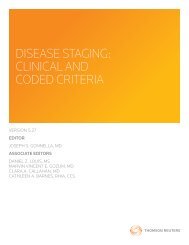HCUP Methods Series - Agency for Healthcare Research and Quality
HCUP Methods Series - Agency for Healthcare Research and Quality
HCUP Methods Series - Agency for Healthcare Research and Quality
Create successful ePaper yourself
Turn your PDF publications into a flip-book with our unique Google optimized e-Paper software.
ICD-9-CM codes requiring special treatmentCCS accounts <strong>for</strong> all changes in ICD-9-CM coding definitions during this time periodexcept <strong>for</strong> two codes whose meaning changed to such an extent that their CCS categoryassignment changed as well. These two codes must be explicitly assigned by the userwhen using older data. If you use more recent data (as described below) no specialtreatment is necessary. The codes are correctly assigned in the CCS program.Assignment of these two codes requires in<strong>for</strong>mation on the year <strong>and</strong> quarter of service.When using data that span the time periods described below, these ICD-9-CM codesmust be assigned to CCS categories explicitly according to the year <strong>and</strong> quarter of thedata.♦ Special treatment is required <strong>for</strong> the following diagnosis code:From January 1980 to September 1993, ICD-9-CM diagnosis code '2510 ' shouldappear in CCS diagnosis category 50 (Diabetes mellitus with complications).Beginning in October 1993, ICD-9-CM diagnosis code '2510 ' appears in CCSdiagnosis category 51 (Other endocrine disorders). The current CCS programassigns this code to category 51.♦ Special treatment is required <strong>for</strong> the following procedure code:From January 1980 to September 1989, ICD-9-CM procedure code '8159' shouldappear in CCS procedure category 153 (Hip replacement, total <strong>and</strong> partial).Beginning in October 1989, ICD-9-CM procedure code '8159' appears in CCSprocedure category 154 (Arthroplasty, other than hip or knee). The current CCSprogram assigns this code to category 154.DESCRIPTION OF DOWNLOADABLE FILESSystem requirementsIn order to use the CCS files you will need a program (such as WinZip®) that will allowyou to decompress or “unzip” files. You will also need approximately 1,500,000 bytesfree on your hard drive to accommodate all the single-level CCS files. You will needapproximately 1,100,000 bytes free to accommodate all the multi-level CCS files oncethey are unzipped."Unzipping" filesThere are two downloadable files, both self-extracting zipped files, called CCS.EXE (<strong>for</strong>the single-level CCS) <strong>and</strong> CCS_X.EXE (<strong>for</strong> the multi-level CCS).Single-level CCSCCS.EXE contains two ASCII (DOS text) files that translate ICD-9-CM codes into singlelevelCCS categories <strong>and</strong> two ASCII (DOS text) files that provide descriptive labels <strong>for</strong>the single-level CCS categories. To use these zipped files, you must do the following:<strong>HCUP</strong> CCS 6/16/2004 9


